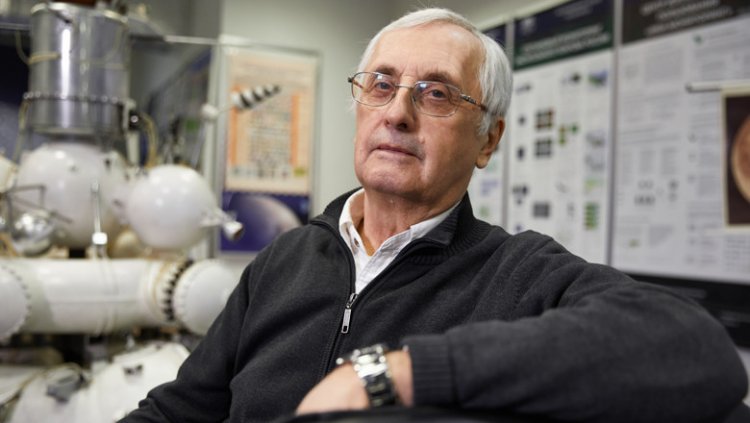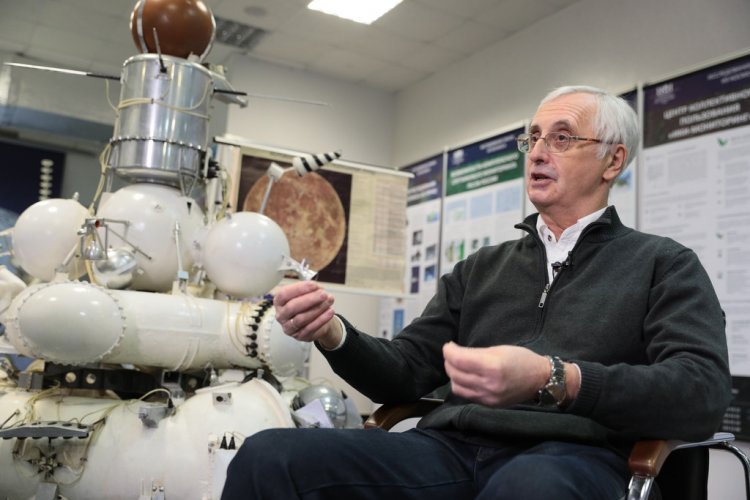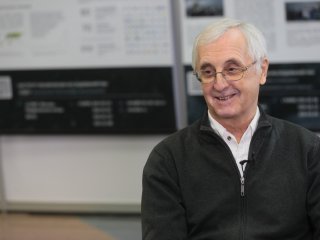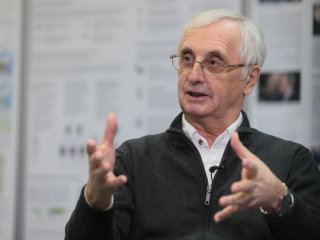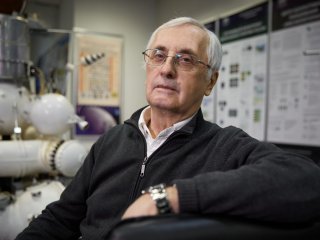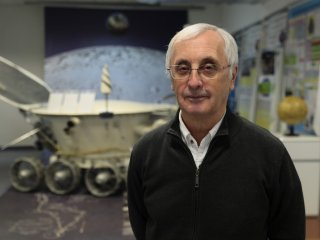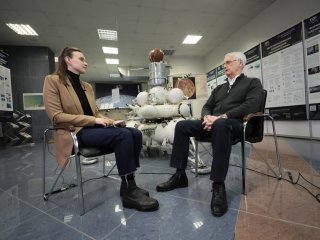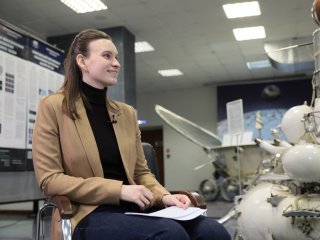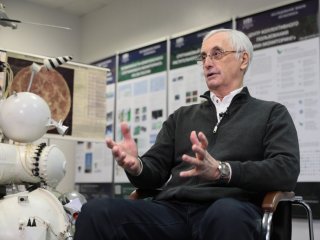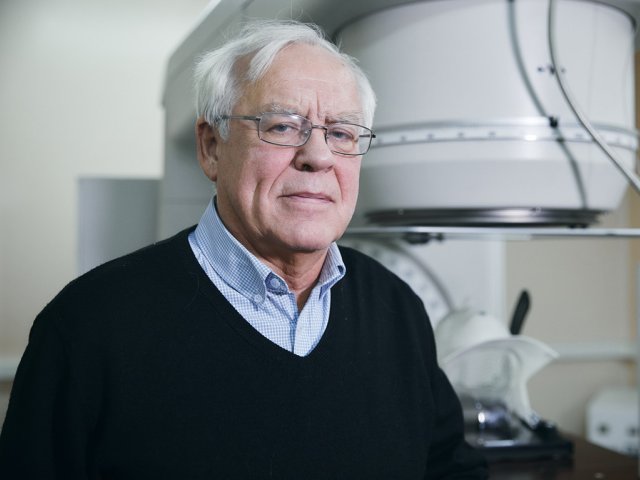In 2021, we celebrate the 60th anniversary of Yuri Gagarin’s spaceflight. His feat opened space for mankind. We grew bold – over half a century of space history, we have built the International Space Station, sent vehicles to the most distant corners of the Solar system and seen the light around gigantic black hole. Today, we dream of making flights to Mars and Moon. These celestial bodies store information about the past of Solar system and the Earth which will allow us to learn what guests had flown here and what they had brought with them. Several decades later, Russia comes back to the Moon. For the first time in history, the space vehicle will start for the satellite’s pole to analyze the ice and lunar soil in this area. Why is it so important? The answer is provided by Igor Mitrofanov.
Igor Mitrofanov, doctor of physics and mathematics, head of nuclear planetology department at the Space Research Institute (IKI) of RAS
— Several decades later, our country returns to the Moon again. What is the reason behind it?
— The main reason lies in the existence of the Earth’s satellite as such. It is obvious that the Moon will become a place of living for mankind in future. While the lunar race of the past century was a political affair, as the USSR and USA wanted to demonstrate their strategic superiority over the rival, we should explore the Moon today just because the human civilization has reached such a stage of development that we can manage it.
In the 21st century, we start for the Moon not to demonstrate our strength, but to take advantage of lunar opportunities gradually, develop lunar resources and finally become the civilization present on two celestial bodies – the Earth and Moon.
— What are the research objectives of Luna-25 mission? What equipment and instruments will be installed on this vehicle?
— As you have mentioned, we come back to the Moon. That is why the vehicle’s name is Luna-25. The name of the previous station was Luna-24. Meanwhile, this lunar mission features novelty related to research. Unlike previous vehicles (the ones which landed on the Moon), Luna-25 will start for the South Pole of the satellite. Nobody has ever landed this close to the pole. It is a unique area. According to the orbital space surveillance data, there are volatile compounds including water in the South Pole area, and ice is present under the surface. This ice will be also studied within the framework of Luna-25 mission.
Another important component lies in the fact that we have not performed lunar flights for a long time. Actually, one cannot take Luna-24 of 1976 style and manufacture the vehicle anew. Everything – the materials and component base – has changed. That is why Luna-25 is a domestic technological experiment in some sense. The project team is to perfect new technologies developed using the modern element base within the framework of lander. That is why the mission has two key elements – research and technological novelty. The successful outcome of it will allow for creating subsequent landers.
— Is one of the elements of instrument base developed by IKI?
— The project is implemented on behalf of the Russian Academy of Sciences, while the Space Research Institute is the leading scientific organization. That is why almost all instruments for Luna-25 have been designed and tested at IKI. It means that our employees are responsible for the whole set of research equipment. Apart from that, we are responsible for the execution of the program in general. The project parties face a very important technical mission of landing the station, checking it and preparing for work. After that, only research tasks will be accomplished. The specifics of them will be determined by the project research group from IKI with participation of the scientists working at other institutions of the Academy of Sciences. Our colleagues from the European Space Agency (ESA) may probably participate in the project too.
—Is the launch scheduled for October this year?
— Yes. We look up to October 1, 2021.
— What is the project team doing today?
— Fortunately, all research instruments have been already tested and handed over to the Lavochkin Research and Production Association – head manufacturing organization. Today the first operations on the lunar surface are being planned.
Many people remember that the Moon rotates on its axis very slowly, actually at the speed of its orbital movement around the Earth – 28 days. That is why, the Moon features very long day and night. Thus, the vehicle will land by approximately by the middle of the lunar day and work up to the lunar night.
Then, Luna-25 has to live through the night. There will be only several earth days between the landing and sleep, and it is necessary to prepare the station for work over this period. This activity is determined by the so-called cyclic graph, i.e. sequence of events.
Right now, we are working out this cyclic graph in order to check all the equipment for working in a routine mode before the first lunar night. Each instrument will report about its state and readiness for work. Besides, it will be certainly very interesting to see the place where Luna-25 has landed, 360-degree panorama of it, what is under the feet of the lander, as well as obtain the first data for research.
— Why is it so important to ensure continuity by way of assigning name Luna-25 to the mission?
— It is important because Russia is a great power, a country with centuries-long history. Our work is inextricably linked to what our predecessors have done. We can start for the Moon again, because Sergey Korolyov launched the first space vehicle to the Moon, we were the first to take photos of the invisible side of the Moon and successfully land on the Moon in automatic mode. Luna-25 bears such a name as we have inherited cosmonautics from the soviet space pioneers. Today, we have new computers and new software, the element base has changed, yet the people are the same. That is why we follow in the footsteps of those who have worked on Kuna-24 mission.
—You must watch the progress of Chinese colleagues who have already brought new samples of lunar soil to the Earth. The competition becomes tougher, doesn’t it?
— Nevertheless, it is not competition. WE observed real competition in the past centuries, when real space race was unfolding. The governments of both the USSR and USA wanted to show their superiority in the international arena. By the way, President John Kennedy who started the implementation of Apollo lunar mission said once that he would not even give a dollar for the sake of science.
Today, the competition is different. It is about the scientists’ aspiration for learning something new about the Universe. We know that there is water on the Moon. That is why the key question that we will try to find an answer to in this competitive environment sounds as follows, “Where did this water come from?”
It is known that there is much water on the Earth, and this water has originated from several sources. First, the Earth formed up of a protoplanetary cloud containing water in the form of hydrated minerals and complex compounds. Such water is likely to exist on the Moon as well, as the Earth and Moon have originated together. Besides water was brought to the Earth by comets – the residues of the matter of protoplanetary cloud generated in the interstellar medium – and we are sure that it is also true for the Moon. Just get the meaning of what we are talking about. We are talking about water which was brought to the Earth 4.5 billion years ago for the interstellar medium that gave birth to the Sun and planets.
It is known that water on comets has many chemical admixtures. Thanks to the methods of astronomical observations, we see the presence of complex molecular compounds and even amino acids. This water with complex chemical composition and interstellar admixtures dissolved in it is likely to be present on the lunar poles too. There are theories saying that the comets falling into the ancient ocean of the Earth would launch complex chemical processes. It might be that comet water, among other things, made an impact on the origin of terrestrial life. We cannot find convincing evidence for it on the Earth, as the earthly environment has been transformed dramatically over the past 4.5 billion years. As for the Moon, everything brought by the comets (chemical elements and admixtures) became condensed and concentrated on the cold lunar poles which are poorly exposed to sunlight. Lunar permafrost sprinkled with regolith is the most interesting parts of Luna-25 and future lunar missions. The analysis of this water will let us find evidence for the hypothesis saying that it is of interstellar origin and probably allow for identifying the very primary complex molecular compounds which have led to the generation of terrestrial life.
Finally, there is the third source of water on the moon. Water is brought by the Sun, no matter how strange it may seem. As is known, the Sun emits the so-called solar wind consisting mostly protons and electrons, while the proton is actually a nucleus of hydrogen atom. Having penetrated not so deep under the lunar surface, such protons come into chemical bonding with oxygen and form H2O. Solar water can be distinguished from the comet one thanks to different relationship between the nuclei of deuterium and hydrogen. Thanks to the research to be carried out, we will analyze not only water of different origin, but characteristics of solar wind in different periods of time as well.
The first data will be provided by Luna-25. Then, we will launch Luna-27 which is to drill the lunar permafrost. One way or another, but the surface is being transfigured all the time due to collision with small asteroids. However, the information about the past of the Earth and Moon that we require may be stored at the depth of 1 meter under the lunar surface. Our ultimate strategic objective lies in delivery of polar matter to the Earth, where it will be analyzed in detail for the presence of molecules from interstellar medium. It is an essential stage of fundamental research, actually an opportunity to solve the mystery of the origin of life.
— Sounds fantastic!
— It is within the framework of such space projects that we will see natural competition among the scientists (which always takes place in research) for the attempt to perceive and explain serious fundamental issues.
— Your scientific activity is related to nuclear planetology among other things. Can you tell me in detail what kind of research area it is, and what modern approaches are used in it?
— Nuclear planetology studies are related to the achievements of nuclear physics which can be used today in the field of space exploration and research. Beyond the terrestrial magnetosphere which does not let charged particles in and atmosphere which slows down the most energetic ones of them, the space is exposed to galactic cosmic rays linked to the processes of active star formation.
The galactic cosmic rays reach the very surface of the Moon. They hit the nuclei of matter which gets excited, as physicists say. Speaking the language of everyday life, each nucleus rings as a bell being hit by proton. Each nuclear has a spectrum of its own. Consequently, the nuclei of each element sound in a different way. Modern gamma-spectrometers (the tools which measure cosmic gamma-rays of excited elements) allow for analyzing spectral lines on frequencies with each of them pointing at some specific element. Analyzing spectral lines, the specialists measure the intensity and mass percentage of each element in the matter.
The soil taken from the areas of middle latitudes has been studied in full measure. As for the soil belonging to polar ones has not been analyzed yet. The research carried out within the framework of nuclear planetology allows for identifying the percent composition of water in the lunar soil brought to the Earth using nuclear line intensity of hydrogen.
In the long run, we can talk about not only scientific research and solving fundamental problems, but using lunar resources as well. The mankind will definitely travel to the Moon again. However, we need water and oxygen, if we want to explore the satellite. Thus, we have to build facilities for producing fresh water from regolith and oxygen required for the life-support system. The gamma-spectrometer installed on the lander module will again indicate the necessary quantity of resources.
— Let us talk about you personally. When did you start taking interest in science?
— I started taking interest in science back in school years. Even at that time, I knew that physics was my vocation. Later, two events influenced my choice of path in life. The first one of them which proved decisive for my life and career was the spaceflight of Yuri Gagarin. As remembered by the contemporaries, many people came out in the streets to celebrate this great event. The date of April 12 has been traditionally celebrated at the Physics Faculty of the Leningrad State University that I studied at as the Day of Physicist. Naturally, this event made a serious impact on our youthful ambitions and subsequent careers. As for nuclear physics, I started taking interest in it after having watched wonderful movie Nine Days in One Year. The script is about the work of nuclear physicists and partially based on a true story.
— What would you wish to the young people who study at physical faculties today and make their future careers in the field of space exploration?
— Learn to think for yourselves. Bear in mind that there are two types of knowledge which you are to grasp. The first type includes the knowledge that other people are already aware of. This knowledge can be obtained from Wikipedia for instance. However, one should get this knowledge from professors to become a really skilled research worker. This knowledge is broader in range and built into the global picture. Getting this knowledge, you will learn to think autonomously.
The second type includes the knowledge that nature conceals from us. The development of science actually means obtaining new knowledge about nature. That is why the main thing for every scientist and his/her successful career lies in learning to think autonomously and becoming such a specialist whose skills and education allow him/her to enter into a dialogue with nature and make it reveal its secrets. For the sake of this very goal it is worth devoting one’s life to science.
